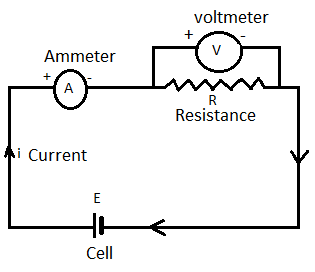
An ammeter and a voltmeter are connected in series to a battery with an emf
A.
B.
C.
D.
Answer
504.6k+ views
Hint: We studied current electricity, in this type of question we use the basic concept of an ammeter and voltmeter. Both the ammeter and the voltmeter are connected in the current carrying circuit for measurement of the current and voltage respectively.
Complete step by step answer:
When the current follows through there is a potential difference between the two points in the electrical circuit, this potential difference is measured by a voltmeter and then an ammeter is used to measure the electric current. For measuring the current and the voltage, these devices are connected series and parallel with the measuring device respectively. A standard voltmeter and ammeter alter the circuit's measurements due to withdrawing of some extra current and by decreasing the current flow respectively.
In the given question, An ammeter and a voltmeter are connected in series to a battery with an emf
When a certain resistance is connected in parallel with the voltmeter , the reading of the voltmeter decreases

After putting the value of current,
The voltmeter reading after the connection of the resistance 4 volt.
So, the correct answer is “Option B”.
Note:
Ammeter has low resistance and the voltmeter has high internal resistance. For the ideal ammeter, resistance is zero. If the resistance of the ammeter is high it will alter the measurements of the flowing current that is why it should be low.
Complete step by step answer:
When the current follows through there is a potential difference between the two points in the electrical circuit, this potential difference is measured by a voltmeter and then an ammeter is used to measure the electric current. For measuring the current and the voltage, these devices are connected series and parallel with the measuring device respectively. A standard voltmeter and ammeter alter the circuit's measurements due to withdrawing of some extra current and by decreasing the current flow respectively.
In the given question, An ammeter and a voltmeter are connected in series to a battery with an emf
When a certain resistance is connected in parallel with the voltmeter , the reading of the voltmeter decreases

After putting the value of current,
The voltmeter reading after the connection of the resistance 4 volt.
So, the correct answer is “Option B”.
Note:
Ammeter has low resistance and the voltmeter has high internal resistance. For the ideal ammeter, resistance is zero. If the resistance of the ammeter is high it will alter the measurements of the flowing current that is why it should be low.
Recently Updated Pages
Master Class 12 Business Studies: Engaging Questions & Answers for Success

Master Class 12 English: Engaging Questions & Answers for Success

Master Class 12 Social Science: Engaging Questions & Answers for Success

Master Class 12 Chemistry: Engaging Questions & Answers for Success

Class 12 Question and Answer - Your Ultimate Solutions Guide

Master Class 11 Economics: Engaging Questions & Answers for Success

Trending doubts
Draw a labelled sketch of the human eye class 12 physics CBSE

a Tabulate the differences in the characteristics of class 12 chemistry CBSE

Which one of the following is a true fish A Jellyfish class 12 biology CBSE

Why is the cell called the structural and functional class 12 biology CBSE

Differentiate between homogeneous and heterogeneous class 12 chemistry CBSE

Write the difference between solid liquid and gas class 12 chemistry CBSE




